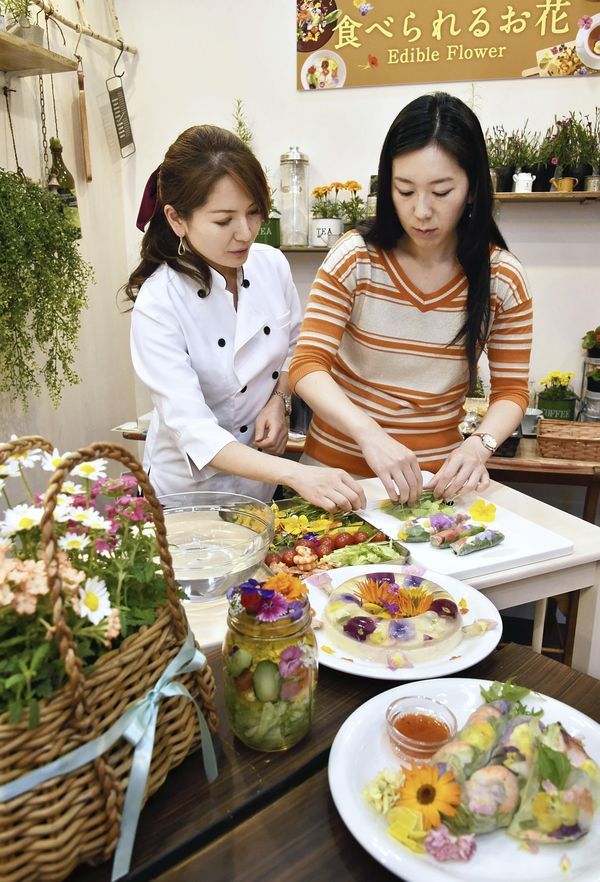Dinner blooms for the tummy
Flowers said to soothe the mind ? and Japanese discovering how they please palate, too
By Korea HeraldPublished : June 23, 2015 - 18:13
Edible flowers are catching on ― Tokyo now has a shop specializing in them. But do they really taste good? And how do you eat them?
Pink alyssum and bluish-purple violas presented like a salad are displayed at Table, Japan’s first edible-flower shop, which opened in the Ikebukuro district in January.
Pink alyssum and bluish-purple violas presented like a salad are displayed at Table, Japan’s first edible-flower shop, which opened in the Ikebukuro district in January.

Jiro Kataoka, president of the marketing company that runs the shop, became aware of the flavors of flowers about a year ago. Kataoka, who grows herbs as a hobby, casually ate the petal of a begonia and found it had a sweet and sour taste like a strawberry. He decided to open the store, thinking, “I want more people to know about this.”
The shop’s main customers are women, but an unexpectedly large number of men come in as well.
“I think they want to surprise their wives and girlfriends,” says Kataoka, 46.
People around the world eat flowers, with some traditions dating back to the pre-Christian period. In Japan, edible chrysanthemums were imported from China about 1,300 years ago, and the flower became widespread in the Edo Period (1603-1867). The famed haiku poet Matsuo Basho wrote, “A butterfly comes and consumes vinegar in a namasu dish using chrysanthemum.”
The term “edible flowers” often refers to Western blooms. They started to become popular in the United States in the 1980s.
Edible flowers are rich in fiber and nutrients such as vitamins and minerals ― a nasturtium has about five times as much vitamin A as a tomato, for example.
There are many flavors of edible flowers, including sweet, sour and spicy. I ate the petal of a nasturtium, and it had a pungent taste like wasabi. In Japan the flower is available at department stores and upscale supermarkets.
Edible-flower growers established a group in mid-April called the Japan Edible Flower Association, comprising six farmers in areas from Hokkaido to Fukuoka. One member is Yuichi Wakisaka, 53, president of the Wakisaka Engei flower-growing company based in Agano in Niigata Prefecture.
A producer of seedlings for flowerbeds such as pansies and marigolds, Wakisaka started growing edible flowers after the 2011 Great East Japan Earthquake. Frustrated that he could only send flowers to disaster-affected areas, he recalled a newspaper article that had featured a dish using edible flowers.
He thought, “People can eat edible flowers and also heal their suffering hearts.”
Since the flowers are to be eaten by people, Wakisaka doesn’t use pesticides. Growing them requires great care, but orders from restaurants and other buyers have been gradually increasing, and Wakisaka’s shipping volume is now three times as much as when he started.
“I want to make the people who eat them smile, with flowers grown with the utmost care,” Wakisaka says.
Saori Kihara, a 25-year-old part-timer in Tokyo’s Adachi Ward, became interested in edible flowers in high school after learning she could eat a purple-red Cooktown orchid that was served in a glass at a cafe.
She wasn’t satisfied doing research in books and on the Internet, so she moved to Tokyo from Fukuoka in April and became qualified as an edible flower coordinator. She now grows six kinds, including verbena and chives, in pots on her balcony.
“They’re beautiful and attractive, and I can experience various flavors,” she says. “I want to use the knowledge I acquired while studying for the qualification to create new dishes using edible flowers, and someday open a cafe.”
I also took a cooking lesson from food researcher Can’Na, trying my hand at Vietnamese spring rolls.
I put shrimp and potherb mustard on rice paper, sprinkled them with violas and marigolds, and then wrapped it all up in rice paper. The rolls looked lovely, since the petals can be seen through the rice paper. When I ate the spring roll, the subtle aromas of the flowers came through.
“It’s also great to mix nasturtiums rubbed with salt into rice or a potato salad,” Can’Na says. She recommends dishes such as cold spaghetti with verbenas, and for the coming season, jellied carnations.
Edible flowers can satisfy people’s stomachs and hearts ― the people growing the flowers and cooking them were all smiling. I will also decorate my table with the dishes I learned about and enjoy the early summer season using all five senses.
By Mayumi Oshige, The Japan News
-
Articles by Korea Herald







![[KH Explains] Hyundai's full hybrid edge to pay off amid slow transition to pure EVs](http://res.heraldm.com/phpwas/restmb_idxmake.php?idx=644&simg=/content/image/2024/04/18/20240418050645_0.jpg&u=20240419100350)







![[From the Scene] Monks, Buddhists hail return of remains of Buddhas](http://res.heraldm.com/phpwas/restmb_idxmake.php?idx=652&simg=/content/image/2024/04/19/20240419050617_0.jpg&u=20240419175937)

![[KH Explains] Hyundai's full hybrid edge to pay off amid slow transition to pure EVs](http://res.heraldm.com/phpwas/restmb_idxmake.php?idx=652&simg=/content/image/2024/04/18/20240418050645_0.jpg&u=20240419100350)

![[Today’s K-pop] Illit drops debut single remix](http://res.heraldm.com/phpwas/restmb_idxmake.php?idx=642&simg=/content/image/2024/04/19/20240419050612_0.jpg&u=)